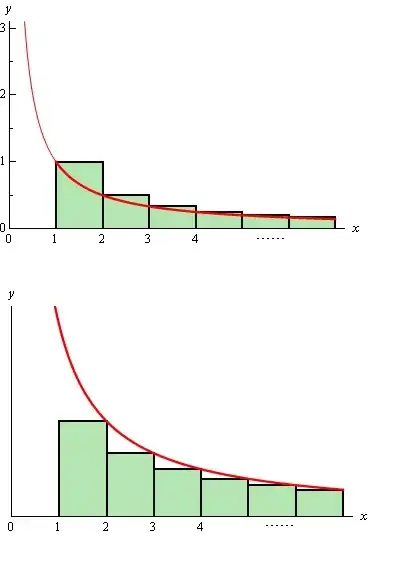I don't know if this helps but following your suggestions I found a way to approach $\ln(1+x)$ using rectangles that have smaller and smaller bases. I don't think this constitutes a proof but shows that adding these rectangles equals $\ln(1+x)$. The result is a function that is nothing more but an infinite sum of infinitesimally small rectangles that mimics perfectly $\ln(1+x)$ for values where $x>-1$. The approach is as follows:
Start by taking the area of a rectangle that has length $x$ and height $f(x)$. The area is $f(x).x$. This is too large and a bad approximation. So break the interval from $1$ to $1+x$ by two intervals of length $\dfrac{x}{2}$. Then the area would be, starting from the left:
$f(1). \dfrac{x}{2} + f(1+\dfrac{x}{2}). \dfrac{x}{2} = \dfrac{x}{2} + \frac{2}{1+x}.\frac{x}{2} = x(\dfrac{1}{2}+\dfrac{1}{2+x}) $
Then, in a third iteration, breaking $x$ into three intervals and calculating the area of the three rectangles, we would get:
$f(1). \dfrac{x}{3} + f(1+\frac{x}{3}). \dfrac{x}{3} + f(1+2\frac{x}{3}). \dfrac{x}{3} = \dfrac{x}{3} + \frac{3}{1+x}.\frac{x}{3} + \frac{3}{1+2x}.\frac{x}{3} = x(\dfrac{1}{3} + \dfrac{1}{3+x} + \dfrac{1}{3+2x}) $
As you can see, a pattern starts to emerge. As we break the $x$ interval into smaller and smaller parts and sum the area of the smaller rectangles we approximate better the area under $f(x)=\frac{1}{x}$. This would give a formula as follows:
$\sum_{k=0}^{n-1}(\frac{x}{n+xk})$
where $k$ represents the begining points of the bases of the rectangles and $n$ represents by how many chunks we break up $x$. Now, take the limit of $n$ going to infinity to get:
$$\lim_{n\to\infty} \sum_{k=0}^{n-1}(\frac{x}{n+xk})$$
and you will notice that this expression is equivalent to $\ln(1+x)$. I don't know how to prove this mathematically, but if you plot both expressions on a graph you will notice that even with a small value of $n$ we approach quite well the $\ln(1+x)$ function. As $n$ increases both functions seem to converge everywhere.
I don't know how the infinite sum relates to the Taylor approximation of $\ln(1+x)$. I suspect that equating this expression or using other tricks might show that both expressions are equivalent, but I have not succeeded at this. Anybody out there has any suggestions?
